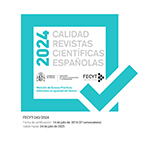Multicorporalidad frente a ocularcentrismo: de la ciudad ojo-individuo a la ciudad sensorial-participada.
Resumen
Algunos autores/as, como Jay (1988, 2003, 2007, 2008), Levin (1988, 1993) o Jenks (1995), han investigado acerca de la influencia del ocularcentrismo en la cultura occidental. Otros/as, como Pallasmaa (2006), han especificado esta influencia en el ámbito arquitectónico y urbanístico. Finalmente, a partir de la década de los ochenta, la antropología sensorial cuestionó el visualismo del pensamiento y cultura occidentales, haciendo hincapié en trascender este sesgo con el fin de conectar con la experiencia cultural de los sujetos no occidentales. Sin embargo, y atendiendo a los avances en esta última disciplina, las taxonomías de los sentidos en las culturas responden a un orden cultural y social determinado por la asignación de mayor o menor valor a nuestros sentidos. ¿Y si cuestionamos dicha taxonomía ocularcéntrica dentro de nuestra propia cultura occidental, valiéndonos de las experiencias de los cuerpos que resisten a dicha jerarquización?
En este artículo se analiza cómo se gestó el ocularcentrismo en la Modernidad y cómo continúa siendo el principal paradigma en la construcción de las ciudades. Más tarde, atendiendo al desmontaje de dichas taxonomías de la mano de la antropología sensorial y utilizando la multiplicidad de tecnologías que en nuestro tiempo permiten la sinestesia e interdependencia de los sentidos, se presenta un proyecto multisensorial para habitar la ciudad. Este proyecto tiene por objetivo facilitar a los participantes habitar los espacios urbanos de maneras diversas, alejadas de las formas normalizadas de interacción.
Descargas
Descarga artículo
Licencia
La revista Cuadernos de Trabajo Social, para fomentar el intercambio global del conocimiento, facilita el acceso sin restricciones a sus contenidos desde el momento de su publicación en la presente edición electrónica, y por eso es una revista de acceso abierto. Los originales publicados en esta revista son propiedad de la Universidad Complutense de Madrid y es obligatorio citar su procedencia en cualquier reproducción total o parcial. Todos los contenidos se distribuyen bajo una licencia de uso y distribución Creative Commons Reconocimiento 4.0 (CC BY 4.0). Esta circunstancia ha de hacerse constar expresamente de esta forma cuando sea necesario. Puede consultar la versión informativa y el texto legal de la licencia.









